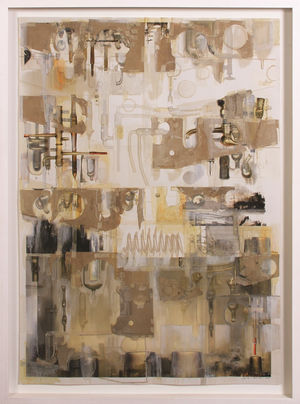top of page
TRANSCODE// Systems and Order. 2011
This body of work formed part of the practice of the DLitt et Phil research.
An additional research component was my curation of the broader exhibition:
Miller, G. 2017. TRANSCODE // DIALOGUES AROUND INTERMEDIA PRACTICE.
Artist's statement
According to Deleuze and Guattari (2004:345), "Transcoding or transduction is the manner in which one milieu serves as the basis for another, or conversely is the establishment atop another milieu, dissipates in it or is constituted in it." Furthermore, new media scholar Lev Manovich (2001:64) writes that to “transcode” something is to translate it into another format.
Today, general society is undergoing a sense of transcoding due to the era of computerization of culture. Within this overarching theme, I sought to make sense of personal archives of artifacts while reflecting on the milieus of home, family and work. Here, the artworks’ idiosyncratic systems symbolise generations within a family and the link between them. Through these works I contemplate family order, personal disorder and professional hierarchy.
(see more below)
Catalogues and reviews
Miller, G. 2017. TRANSCODE // DIALOGUES AROUND INTERMEDIA PRACTICE.
outoftheCUBE in SA Art Times, October 2016: pages 22 and 23.
Selected works taken up in the collection of SAMHS can be viewed in their catalogue at
SOUTH AFRICAN MILITARY HEALTH SERVICES CATALOGUE OF ARTWORKS
Several reworked images were exhibited at Terra Pericolosa curated by Elfriede Dreyer, first at Fried Contemporary Art Gallery,
Catalogue available: Terra Pericolosa Catalogue
Thereafter at Terra at Oliewenhuis Art Museum, pages 52 and 53:
Reviewed by Nathani Luneburg in De Arte, Volume 2012, Issue 86, Jan 2012, p. 39 - 57
The Terra series: 'Terra Firma','Terra Nullius', 'Terra Incognita.
Miller’s striking installation, named Residual system (2011/ 2012) (3), also speaks about that instant before catastrophe strikes and emphasises human systems designed to tame nature. The artwork rests on a rusty iron floorplate and consists of a Perspex display case containing what appears to be a minuscule laboratory made up of laboratory glass, handmade glass and lights. The artist’s intention is to portray systems of biological legacy and she refers to systems of residue as the damage caused by power struggles (Dreyer 2012:9–11). In this installation Miller reduces the human mapping system to a scientific arrangement, revealing how people attempt to control and manipulate human biology and how such experiments have left a residue of harm through the passing of time.
bottom of page






















